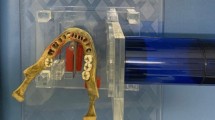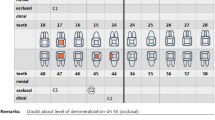Abstract
Objectives
To investigate the performance of radiographic systems with automatic exposure compensation (AEC) on the caries diagnosis in images acquired with different exposure parameters and in the presence of high-density material. Also, the image quality was assessed.
Methods
Forty posterior teeth (80 proximal surfaces) were radiographed using a phosphor plate and a CMOS system. Images were acquired with different exposure times (0.06, 0.10 and 0.16 s) and kilovoltages (60 and 70kVp), in the absence and presence of high-density material in the X-rayed region (control and high-density groups). Five radiologists assessed the caries using a 5-point scale. Diagnostic values were compared using two-way ANOVA.
Results
For both radiographic systems, there were no significant differences in the area under the ROC curve (0.60–0.73), sensitivity (0.79–0.87) and specificity (0.29–0.48) between the control and high-density groups, exposure times or kilovoltages (p > 0.05). For image quality, scores assigned to the control and high-density groups were similar in each exposure protocol in both systems.
Conclusions
The presence of high-density material, exposure time and kilovoltage did not affect the caries diagnosis in any of the systems tested. It is recommended to use protocols with lower doses to reduce the patient's exposure.



Similar content being viewed by others
References
Kayipmaz S, Sezgin ÖS, Saricaoğlu ST, Çan G. An in vitro comparison of diagnostic abilities of conventional radiography, storage phosphor, and cone beam computed tomography to determine occlusal and approximal caries. Eur J Radiol. 2011;80:478–82. https://doi.org/10.1016/j.ejrad.2010.09.011.
Yoshiura K, Nakayama E, Shimizu M, Goto TK, Chikui T, Kawazu T, Okamura K. Effects of the automatic exposure compensation on the proximal caries diagnosis. Dentomaxillofac Radiol. 2005;34:140–4. https://doi.org/10.1259/dmfr/88681265.
Hayakawa Y, Farman AG, Scarfe WC, Kuroyanagi K. Technical report. Processing to achieve high-contrast images with computed dental radiography. Dentomaxillofac Radiol. 1996;25:211–4.
Galvão NS, Nascimento EHL, Lima CAS, Freitas DQ, Haiter-Neto F, Oliveira ML. Can a high-density dental material affect the automatic exposure compensation of digital radiographic images? Dentomaxillofac Radiol. 2019;48:20180331. https://doi.org/10.1259/dmfr.20180331.
Hayakawa Y, Farman AG, Scarfe WC, Kuroyanagi K. Pixel value modification using RVG-4 automatic exposure compensation for instant high-contrast images. Oral Radiol. 1996;12:11–7.
Dashpuntsag O, Yoshida M, Kasai R, Maeda N, Hosoki H, Honda E. Numerical evaluation of image contrast for thicker and thinner objects among current intraoral digital imaging systems. Bio Med Res Int. 2017;1:1–10. https://doi.org/10.1155/2017/5215413.
Galvão NS, Nascimento EHL, Gaêta-Araujo H, Freitas DQ, Haiter-Neto F, Oliveira ML. Automatic exposure compensation and subjective image enhancement in the radiographic diagnosis of caries. Braz Oral Res. 2020;34: e082. https://doi.org/10.1590/1807-3107bor-2020.vol34.0082.
Landis JR, Koch GG. The measurement of observer agreement for categorical data. Biometrics. 1977;33:159–74.
Haiter-Neto F, Wenzel A, Gotfredsen E. Diagnostic accuracy of cone beam computed tomography scans compared with intraoral image modalities for detection of caries lesions. Dentomaxillofac Radiol. 2008;37:18–22. https://doi.org/10.1259/dmfr/87103878.
Pontual AA, de Melo DP, de Almeida SM, Bóscolo FN, Haiter NF. Comparison of digital systems and conventional dental film for the detection of approximal enamel caries. Dentomaxillofac Radiol. 2010;39:431–6. https://doi.org/10.1259/dmfr/94985823.
Wenzel A, Hirsch E, Christensen J, Matzen LH, Scaf G, Frydenberg M. Detection of cavitated approximal surfaces using cone beam CT and intraoral receptors. Dentomaxillofac Radiol. 2013;42:39458105. https://doi.org/10.1259/dmfr/39458105.
Nascimento EH, Gaêta-Araujo H, Vasconcelos KF, Freire BB, Oliveira-Santos C, Haiter-Neto F, Freitas DQ. Influence of brightness and contrast adjustments on the diagnosis of proximal caries lesions. Dentomaxillofac Radiol. 2018;47:20180100. https://doi.org/10.1259/dmfr.20180100.
Melo SLS, Belem MD, Prieto LT, Tabchoury CP, Haiter-Neto F. Comparison of cone beam computed tomography and digital intraoral radiography performance in the detection of artificially induced recurrent caries-like lesions. Oral Surg Oral Med Oral Pathol Oral Radiol. 2017;124:306–14. https://doi.org/10.1016/j.oooo.2017.05.469.
Oliveira LB, Massignan C, Oenning AC, Rovaris K, Bolan M, Porporatti AL, De Luca CG. Validity of micro-CT for in vitro caries detection: a systematic review and meta-analysis. Dentomaxillofac Radiol. 2020;49:20190347. https://doi.org/10.1259/dmfr.20190347.
Funding
This study was financed in part by the National Council for Scientific and Technological Development—Brasil (CNPq).
Author information
Authors and Affiliations
Corresponding author
Ethics declarations
Conflict of interest
None.
Ethics approval
This study was developed after approval by the Research Ethics Committee of the Federal University of Pernambuco (protocol CAAE: 19141419.0.0000.5208).
Informed consent
Not applicable.
Additional information
Publisher's Note
Springer Nature remains neutral with regard to jurisdictional claims in published maps and institutional affiliations.
Rights and permissions
About this article
Cite this article
Gomes, I.R.L., Nascimento, E.H.L., Gaêta-Araujo, H. et al. Radiographic diagnosis of proximal caries is not affected by exposure protocols and presence of high-density material on systems with automatic exposure compensation. Oral Radiol 38, 356–362 (2022). https://doi.org/10.1007/s11282-021-00565-z
Received:
Accepted:
Published:
Issue Date:
DOI: https://doi.org/10.1007/s11282-021-00565-z




